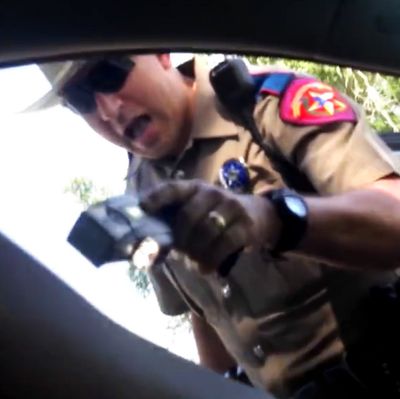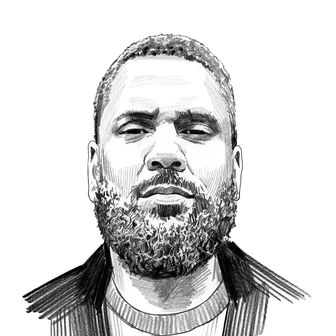
Brian Encinia said that he ordered Sandra Bland out of her vehicle, forced her to the ground, and handcuffed her on July 10, 2015, because he feared for his safety. “My safety was in jeopardy at more than one time,” the former–Texas Department of Safety trooper told the agency’s Office of Inspector General. “I had a feeling that anything could’ve been either retrieved or hidden within her area of control.”
But newly released footage contradicts this account. On Monday, reporters with Dallas television station WFAA aired a 39-second cell phone video captured by Bland that had not been previously made public. It depicts an irate Encinia threatening to “light … up” the black 28-year-old with his stun gun and demanding that she exit her car and “get off the phone,” all while Bland asks him repeatedly why a “failure to signal” called for such treatment. “The video shows that [Encinia] wasn’t in fear of his safety,” Cannon Lambert, a lawyer for Bland’s family, told the New York Times. “You could see that it was a cell phone. He was looking right at it.”
Bland was found dead in a Waller County jail cell three days later; authorities ruled her death a suicide. Nationwide protests followed. The Naperville, Illinois, native — who, before her arrest, was en route to start a new job at Prairie View A&M University in Prairie View, Texas — became the most prominent woman to die in police custody as a result of police violence during the height of the Black Lives Matter movement.
Encinia was charged with perjury for lying about the circumstances surrounding Bland’s arrest, but the charges were dropped on the condition that he never seek a job in law enforcement again. As a result, Encinia — whose former lawyer told the Times that he is now “working in the private sector, supporting his wife and family and living a quiet life” — became one of the countless American police officers to face no legal consequences for demonstrated misconduct.
The gravity of Encinia’s behavior falls short of the murderousness shown by Michael Slager and Jason Van Dyke, police officers who were convicted of crimes after shooting and killing black men. But it is an edifying example nonetheless in the debate over whether cases of police misconduct are a series of isolated incidents or part of a systemic problem. Public opinion is divided on the issue — but perhaps predictably, the divide is largely racial and politically partisan. According to a 2015 PRRI survey conducted after the killings of Mike Brown and Freddie Gray, 74 percent of black Americans believed that such killings were part of a broader pattern of police behavior, compared to 43 percent of white Americans. Thirty percent of Democrats felt they were isolated incidents, compared to 65 percent of Republicans.
The position held by most whites and Republicans can be summarized as the “bad apple” theory of law enforcement — the idea that a few bad actors exist but should not reflect poorly on an otherwise-good bunch. Prominent subscribers include former–U.S. Attorney General Jeff Sessions, who has deployed this argument to discredit federal oversight of local police departments. “I think there’s concern that good police officers and good departments can be sued by the Department of Justice when you just have individuals within a department who have done wrong,” the then-senator said in 2017. About 67 percent of police officers agree with Sessions that these occurrences say little about policing as a whole.
But what happens in their immediate aftermath is just as illuminating in uncovering the truth as the incidents themselves. Encinia did not just order Bland out of her car, threaten her, and arrest her for apparently frivolous reasons. He lied to investigators about the threat that he believed she posed. His official account of the exchange hinged entirely on the assertion that his actions were justified because he thought he was in danger. And he is not alone in pursuing this line of reasoning. Almost every prominent police killing or assault of an unarmed black person in recent years has been followed by official claims that the officer feared for his or her safety. In cases as disparate geographically as the shooting deaths of Mike Brown in Missouri, Terence Crutcher in Oklahoma, Sam Dubose in Ohio, and the 15-year-old boy attacked in April by sheriff’s deputies in Broward County, Florida, police have invoked the fear they purportedly felt to justify their violence.
This approach has yielded dividends. Department policy and Supreme Court precedent have combined to render more or less legal the brutalization of civilians, as long as the officer in question can demonstrate that their actions were “objectively reasonable.” Of course, what is considered “objectively reasonable” shifts from state to state and case to case — such that more often than not, merely claiming to have felt fear is treated as objectively reasonable grounds for murder.
We can say with confidence that this is a systemic problem because letting these officers off the hook is a systemic act — enshrined in law and practice across the United States and carried out in official press conferences, departmental investigations, and grand jury proceedings. “A few bad apples” are not to blame for a system-wide mechanism which police can so reliably turn to for exoneration that they do so almost every time they are caught doing wrong. There is something fundamentally nefarious about the whole institution when so many such cases follow a familiar script: Commit violence against an unarmed civilian, then claim — often dishonestly — to have been so frightened that no other option was available.
Sandra Bland may have been mistreated by a lone officer on the street that day. But it was the system that empowered Encinia to treat her as he did in the first place — and that gave him confidence that even if the encounter ended with her dying, he could lie and expect to be protected.






























